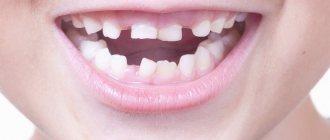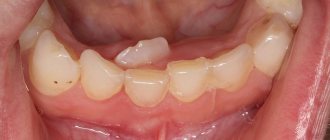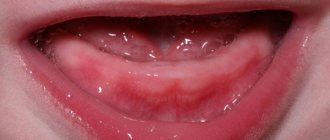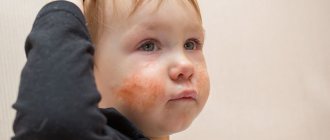September 24, 2018
Averyanova Sveta
All parents eagerly await the appearance of the first incisors. This is an important life stage for boys and girls. It is accompanied by unpleasant symptoms, pain and moodiness. You can find out when children start teething normally, what is the reason for the delays and how to help your baby cope with discomfort in our article.
When teeth start cutting
The first incisors appear between 4 and 7 months of age. The pattern of teething in children is approximately the same, but the timing is different. Some babies remain toothless for up to a year, but then quickly catch up with their peers. And others already by 6–8 months become the owners of 2–4 teeth.
The process of formation of the milk chewing apparatus ends by 3 years. By this time the baby should have 20 teeth. If there are minor delays in the appearance of the first incisors, then there is no need to worry. If by the age of one and a half years there are no signs of their eruption, seek help and advice from a doctor.
Forms of caries of primary teeth in children -
As we said above, caries can occur in children as early as 1 year of life, starting from the moment the primary teeth erupt. Caries of permanent teeth also begins in children from the moment they erupt, i.e. at the age of 5-6 years. And if in preschoolers and schoolchildren the resulting carious defect can exist for quite a long time (until the transition of caries to pulpitis and periodontitis), then in children under 2-3 years of age, a rapid development of caries and its complications is usually observed. The reasons for this are the following factors:
- weak enamel mineralization,
- a very thin layer of tooth enamel,
- a very thin layer of dentin (only 1-2 mm) that separates the enamel from the pulp of the tooth.
Therefore, even from shallow carious defects, bacteria very quickly enter the pulp (the neurovascular bundle located in the center of the tooth) and first cause the development of inflammation and then the death of the pulp. Therefore, parents should pay attention not only to the appearance of already typical carious defects. The initial form of caries in children is manifested in the formation on the surface of the enamel - white chalky spots (foci of demineralization), the appearance of which precedes the occurrence of carious defects themselves.
Forms of dental caries in children:
- The initial form of caries (Fig. 5-6) - with irregular oral hygiene, microbial plaque accumulates at the necks of the teeth. Plaque bacteria produce acid, which begins to dissolve the already weakly mineralized enamel, which leads to the formation of foci of demineralization on the surface of the tooth enamel. The latter look like white chalky spots, slightly rough to the touch.
Parents often do not notice the appearance of such spots in time, because... they are hidden under a layer of soft plaque. Or the parents do not see anything serious in their appearance. If during this period there is no normalization of the child’s oral hygiene, as well as his diet, the white spots on the surface of the enamel very quickly turn into superficial carious defects.
- Superficial caries (Fig. 7) - at this stage of caries development, only the tooth enamel is affected, i.e. The carious process does not yet affect the layer of dentin located under the enamel. Superficial carious defects usually appear directly on the site of previous foci of demineralization (white chalky spots). By the way, this is clearly visible in Fig. 2.
- Middle caries (Fig. 8-9) - at this stage of development, the bottom of the carious cavity is localized already below the enamel-dentin border, i.e. located in the middle layers of dentin. If initial and superficial caries remain, as a rule, unnoticed by parents, then intermediate caries is clearly visible on the surface of the tooth. In addition, children may already experience short-term pain when eating cold or sweet foods, but young children are not able to express their feelings.
Moreover, in children under 2 years of age, tooth damage by medium caries most often tends to unlimited planar and circular distribution. Those. A carious lesion can occupy several entire tooth surfaces at once. And only after 2 years of age, the carious lesion will have its usual appearance - a limited carious cavity (saucer-shaped). - Deep caries (Fig. 10) is the next stage in the development of the carious process, but in children under 3 years of age this form of caries practically does not occur. The latter is due, among other things, to the fact that in children of this age group the thickness of dentin is only 1-2 mm, and therefore, even with a shallow carious cavity, infection of the pulp (neurovascular bundle) quickly occurs - with the subsequent development of pulpitis and periodontitis.
Symptoms
Teething in babies is a natural process. This age period is perceived by mothers as the most difficult. The small organism malfunctions, the baby experiences constant discomfort.
It is easy to recognize that a baby is cutting its first teeth by the following accompanying signs:
- Increased salivation. It begins 1–2 months before the appearance of the incisors.
- The desire to scratch the gums, chew something. The baby puts fingers, toys, and diapers into his mouth. He chews everything he can get his hands on with pleasure and calms down. This sign is common to all children.
- Increased nervousness, moodiness. The baby cries, tugs, and feels his gums.
- Sleep disorders. Babies 3–6 months old wake up at night, rock hard, and won’t let the bottle or breast out of their mouth. In rare cases, newborn toddlers may cry all night and day long. Don’t worry, the child is in severe pain, the tooth will appear soon.
- Lack of appetite, complete refusal to eat. It is observed at the stage of active tooth eruption. Hunger strike or weak appetite lasts 2-3 days.
- The lymph node behind the ears is inflamed. The bump does not pose a threat to the baby. To rule out the disease, get tested, check the level of leukocytes and lymphocytes.
- Swelling, swelling of the gums. Redness and swelling are observed at the site of the future tooth. The remaining parts of the gums are calm.
- Increase in body temperature during teething. Hyperthermia manifests itself in different ways. In some infants, the temperature rises by 1–1.5 degrees, in others it goes off scale – up to 39–40°C, lasting from one to three days. Important! If your baby has a high temperature for four or more days, the gums are completely swollen, there is diarrhea, or skin irritation, consult a doctor. Perhaps the cause of the discomfort was not the teeth, but an infection.
- Runny nose, mild wet cough. These signs of teething are triggered by copious amounts of saliva. They have nothing to do with colds.
- Diarrhea. Weak loose stools are observed for one to two days. Your stomach may hurt.
- Irritation on the skin of the face and chest. Red spots and itching of the epidermis are provoked by children's saliva, which gets on the chin, cheeks, and neck.
This is interesting! Increased salivation saves the baby from some discomfort during teething. Saliva has an antibacterial and analgesic effect. If the incisors appeared unaccompanied by a large amount of moisture in the mouth, then the kids would experience much more discomfort.
Complications of caries in children -
As we said above, in children under 3 years of age, newly appeared caries can turn into pulpitis (inflammation of the nerve in the tooth) in just 2-3 months, which is also due to the too small thickness of enamel and dentin.
The resulting pulpitis can have either an acute or chronic course. The acute course of pulpitis in primary teeth is characterized by the occurrence of spontaneous paroxysmal pain, especially at night and in the evening. The pain is usually provoked by hot or cold food, and after eliminating the irritant it can last from 15 minutes to several hours. In the chronic course of pulpitis of primary teeth, pain symptoms may either be completely absent, or pain may occur during meals (due to irritation of the receptors in the area of the bottom of the carious cavity by the food lump). This form of pulpitis can be very difficult to distinguish from average caries, which often leads to medical errors. Mistaking pulpitis for average caries, the doctor traditionally treats it with silvering or filling, which inevitably leads to the development of periodontitis (24stoma.ru).
But in the absence of treatment, pulpitis in any case sooner or later transforms into periodontitis (purulent inflammation at the apex of the root). The following symptoms are characteristic of periodontitis in primary teeth: 1) an abscess periodically appears on the gum in the form of a lump filled with pus, 2) fistulas with purulent discharge periodically open in the projection of the root of the diseased tooth on the gum. What purulent inflammation looks like during periodontitis (Fig. 15-16).
The occurrence of fistulas and purulent lumps on the gums is an absolute indication for tooth extraction (regardless of how much time is left before its physiological change). The fact is that purulent inflammation at the apex of the root of a baby tooth can most likely cause inflammation of the germ of a permanent tooth, which is located only 1-2 mm from the tops of the roots of a baby tooth. In addition, bacteria and toxins will constantly enter the blood, leading to deterioration of immunity and the development of a number of chronic diseases (for example, diseases of the ENT organs, bronchial asthma, allergies, etc.).
You can read about what needs to be done if your child has a fistula or purulent abscess on his gum in the article at the link above.
Possible reasons for the delay
The absence of baby teeth by the age of one year alarms parents and pediatricians. The reasons for delays in the formation of the masticatory apparatus are the following factors:
- Calcium deficiency. At one year of age, children with rickets have no milk teeth. Calcium may not be absorbed due to disruptions in the gastrointestinal tract and metabolic disorders.
- Heredity. If one or both parents developed incisors late, their children will inherit the same feature. There is no way to speed up the natural process.
- Edentia. There are no tooth primordia in the jaw. Adentia can be complete or partial. You can see how many tooth germs there are in the jaw using an x-ray. The procedure is prescribed by a dentist.
- Hormonal disorders. Malfunctions of the thyroid gland shift the timing of a baby’s development.
- Infectious diseases at an early age. Past illnesses affect the body’s supply of necessary vitamins and minerals and disrupt the rhythm of development.
- Prematurity. In children born prematurely, all physiological processes are often delayed by one to two months.
Treatment of childhood caries
Depends on age, group affiliation (permanent or milk), the nature of the course of caries and the level of hygiene.
Treatment of childhood caries without drilling teeth
Initial and superficial caries can be treated without drilling. In case of initial caries (in the staining stage), the tooth is covered with special strengthening solutions (fluoridation, mineralization). Removal of carious tissues can be carried out without the use of burs (use of hand instruments, air abrasive preparation).
Fluoridation and mineralization
The principle of mineralization is the saturation of the tooth with mineral components lost due to caries. These include compounds of fluorine, calcium and phosphorus that are part of hydroxyapatite, the main component of enamel. Remineralization can be done at home or professionally.
- Home remineralization includes the use of fluoride in children's pastes and gels.
- For professional remineralization of carious lesions, the following are used:
● applications of calcium gluconate and sodium fluoride; ● deep fluoridation method (enamel-sealing liquid).
Remineralizing therapy is accompanied by fluoridation. Fluorine has the following effects:
- participates in the formation of fluorapatite (strengthens enamel);
- reduces the intensity of carbohydrate breakdown (fewer acids are formed that destroy teeth);
- disrupts the attachment of bacteria to the tooth (prevents the growth of microbial plaque).
Fissure sealing
Sealing is the sealing of fissures and other natural recesses with special dental materials containing fluorides (glass ionomer cements).
If initial caries is detected, it is preceded by removal of the affected tissue. Instead of drilling, the doctor does kinetic preparation. Under high pressure, an abrasive agent (aluminum oxide or sodium bicarbonate powder) is supplied from the tip, which erases carious tissue.
Sealing
Filling a tooth with dental materials is preceded by the removal of carious tissue. Without their removal, caries will continue to develop under the filling, which can lead to undesirable consequences (pulpitis, periodontitis). Sometimes the affected tissue can be removed without drilling.
The ART method involves treating the carious cavity with special hand tools (a hand excavator or an enamel knife) - ensuring painless and gentle excision of caries.
In children, fillings that release fluoride are used. Light-curing composite materials are not used:
- in young children (the child is not able to sit for a long time with his mouth open);
- for extensive restorations;
- with multiple caries, poor hygiene.
Teething order
Baby teeth should emerge in a pattern determined by nature. The timing varies greatly.
We present the average age indicator for the formation of the masticatory apparatus, which is accepted by pediatricians. The normal sequence should look like this:
- Central incisors - 4 teeth. First, the 2 lower ones come out - from the 6th to the 10th month, then the 2 upper ones - from the 7th to the 12th month.
- Lateral incisors - 4 teeth. By the 9th–12th month, 2 upper incisors appear, by the 7th–16th month, 2 lower ones.
- Fangs - 4 teeth. They usually grow almost simultaneously from the 16th to the 23rd month.
- The first molars are 4 teeth. The bottom erupts from the 12th to the 18th month, the top - from the 13th to the 19th month.
- Second molars - 4 teeth. Last milk teeth. The lower ones appear at the end of the baby’s second year of life - up to the 31st month, the upper ones - from the 25th to the 31st month.
To track how children's teeth grow according to the schedule, use the picture. Print out the calendar and hang it in a visible place, noting the incisors that have already appeared.
Print the calendar in large format (click on the image to enlarge) and fill it out with your child:
Individual characteristics of the appearance of teeth
It is worth noting that there is no single answer to the question of what time a baby’s first teeth begin to cut, since the development of a child as a whole is of a purely individual nature. But, on average, the appearance of teeth can be expected in the range of four to nine months.
This process is influenced by many factors. Among which:
- genetic predisposition and heredity for the appearance of teeth in a child
- living conditions of the baby - climate, nutrition
- compliance with the regime during the mother's pregnancy.
The gender of the child also influences. Doctors have noted that the appearance of the first teeth in girls occurs much earlier than in boys, which characterizes the general trends in the development of children.
Girls under one year of age develop more rapidly, begin to walk earlier and, sometimes, by this age they utter their first words.
Scheme of eruption of permanent teeth
Children acquire a full permanent set of teeth by the age of 12–15 years. Teeth begin to renew in older preschool age, at 5–6 years. But first, “sixes” will come out in the place where there were no milk teeth. These are called first molars and will be replaced by premolars after age 10. “Sixes” fill the gap in the jaw before the first baby teeth fall out.
The remaining baby teeth will emerge in the following sequence, shown in the table:
| № | What teeth are coming through? | Child's age, years |
| 1. | Central lower incisors | 6–7 |
| 2. | Central upper incisors | 7–8 |
| 3. | Bottom twos | 7–8 |
| 4. | Upper lateral incisors | 8–9 |
| 5. | Lower canines | 9–10 |
| 6. | Upper canines | 11–12 |
| 7. | First upper premolars | 10–11 |
| 8. | First lower premolars | 10–12 |
| 9. | Upper second premolars | 10–12 |
| 10. | Second lower premolars | 11–12 |
| 11. | Second lower molars | 11–13 |
| 12. | Upper second molars | 12–13 |
| 13. | Third upper and lower molars | 17 and older |
A graphic diagram will help you understand the order of formation of a permanent bite:
The baby's body's reaction to the first teeth
When children are teething, there is nervousness, fuss and confusion in the house.
In an instant, the baby turns from an easygoing and smiling angel into a whiny and irritable one. At the age of six months, a child’s body experiences a lot of stress, and for the first time the baby encounters constant pain, itching, and discomfort in the mouth.
During this difficult period, parents need to be patient. Take the advice of Dr. Komarovsky: “Give the baby all your love, pick him up more often, warm him with your warmth, kiss him, hug him. Feeling the support, affection and understanding of your parents will make the process of cutting your first teeth less stressful.”
And here is Dr. Komarovsky’s full video on this topic:
In order to properly help a child survive a difficult stage, parents need to understand the cause of whims, snot, cough, diarrhea and other external manifestations of malfunctions in the body. Let's look at each problem separately.
Increased salivation
It occurs due to the active work of the salivary glands during the preparation of the gums for the appearance of the first incisors. Excess moisture in the mouth plays a huge role in protecting the oral cavity from infections; it contains immune cells.
At the moment of teething, the child’s body weakens, the baby puts his hands and any objects into his mouth, and saliva can kill viruses and microorganisms dangerous to health. More often, salivation returns to normal after the appearance of the first 2–4 incisors, when the child is already stronger.
Runny nose
It is provoked by bacteria and viruses, which the infant’s body cannot fully resist during this period.
Snot appears due to excess saliva. It enters the middle ear and flows down the nasal passages. Congestion and sneezing are first noticed a few days before the incisor appears and disappear immediately after the edge of the tooth emerges from the gums.
Coughing
The airways become clogged with copious amounts of saliva. The child cannot swallow it quickly, so he is forced to cough and may sneeze. If saliva gets into the nasopharynx and accumulates there, the parents will hear soft wheezing in the baby’s chest.
If the cough is not caused by ARVI, it appears at night. During sleep, the baby is in a horizontal position, and it is difficult for saliva to flow down the throat on its own. The baby coughs up excess moisture every 15–30 minutes as a reflex. The symptom does not require treatment.
Important! If the cough is severe, accompanied by wheezing, high fever, or rash, consult a doctor and get tested.
Diarrhea or constipation
The baby's stomach reacts violently to any changes in diet, drinking regimen, and rest. Diarrhea at the time of teething is provoked by excessive saliva, stress, and sleep disturbances. Constipation in infants occurs much less frequently at this time.
It is important not to confuse disruptions in the gastrointestinal tract due to the appearance of teeth and poisoning. Normally, the stool does not change globally, diarrhea lasts from 24 to 72 hours, the stool will not be too liquid.
Vomiting, nausea
Very rare. It is provoked by excess saliva and cough. If the baby vomits frequently and there is severe diarrhea, then we are talking about poisoning or gastrointestinal diseases. In this case, you need to seek medical help.
Swelling of the gums
Parents can see swelling in the baby's mouth and feel it to the touch. When examining the oral cavity with the naked eye, a small bump on the gum is noticeable and is easy to feel. It is in this place that the tooth will soon appear.
Sometimes a small blood clot forms on or near the tubercle, and the vessel is ruptured by the erupting tooth. After one or two days, the gums will turn blue and a hematoma will form. This is considered the norm.
Swelling of the gums is accompanied by pain and itching. Pustules appear in the mouth if an infection gets into the cavity, the baby is injured by the sharp edges of toys, or nails when scratching the gums. In this case, the entire oral cavity will swell.
Decreased appetite
The baby may refuse to eat at all or eat very poorly. There is no need to insist. The child's body is busy with the formation of the chewing apparatus. Eating and digesting take away energy. When everything is over, the baby will definitely make up for the lack of nutrients.
Fever
Due to teeth, infants have a fever for no more than three days; the body heats up to 38.5°C. This is due to inflammatory processes on the gums and infection in open wounds in the mouth. Relief occurs immediately after the tooth comes out.
Temperatures rarely rise to 39–40 degrees. Such indicators are usually recorded in weakened children who often suffer from colds.
If hyperthermia continues for more than three days, the increase is significant, you need to consult a doctor. Most likely, this symptom has nothing to do with teeth.
Skin rash
The epidermis is irritated on the lower part of the face, chest, neck, and arms. The rash is caused by saliva. It gets on open parts, the active secretion corrodes the delicate skin. The epidermis on the fingers becomes inflamed when the child puts them behind the cheek to scratch the sore spot or bites them with the gums.
The irritated areas itch, tingle, and the integrity of the skin is compromised, which causes additional discomfort for the baby.
Irritability, moodiness
The reason lies in general malaise, fatigue, and painful sensations in the mouth. The gums are rich in nerve endings, so swelling and teething are felt clearly and sharply by the baby.
Improvement in the condition occurs immediately after the gum ruptures at the top of the tooth. The baby stops being capricious, begins to smile, eat, and sleep soundly.
Desire to gnaw, bite
Even one-year-old babies try to scratch their sore gums at the moment of cutting in another tooth, and even more so for six-month-old babies. The gums hurt, itch, and may increase in size due to swelling. If the baby chews on something hard, the pain subsides and temporary peace sets in.
For these purposes, babies use any objects, including their own hands. It is very important for parents to monitor their baby at such moments. Plastic toys with sharp edges can hurt your gums, and your hands are full of harmful bacteria.
The body's reaction to the eruption of baby teeth is different for all children. If your baby is lucky, the first front incisor will come out asymptomatically, without causing concern to parents and child.
Use of Medicines
Modern pharmacies sell a lot of products to help babies teething. These are gels, ointments, sprays, drops. They have an anti-inflammatory, analgesic effect, relieve itching and burning. With their help, the period of teething is easier for children, but it will not be possible to completely relieve pain and anxiety.
The following tools are popular among parents and pediatricians (Important! The table can be scrolled left and right on mobile devices):
| A drug | Properties | How to use | Contraindications |
| Gel "Cholisal" | Relieves inflammation, redness, and soothes gum pain. | Apply 2-3 times a day | • Age up to one year. • Intolerance to choline salicylate, cetalkonium chloride. • Breast-feeding. |
| Gel "Kamistad Baby" | Fights germs, relieves pain, relieves redness in the mouth, swelling, heals wounds. | Apply to inflamed gums 3 times a day, no more than 5 mm per application. | • Age up to 3 months. • GV. • Individual intolerance to lidocaine. • Diseases of the kidneys, liver, heart. • Increased blood pressure. |
| Drops, gel "Dentinox" | Pain reliever. | Apply to gums 3 times a day. | Allergies |
| Homeopathic gel “Baby Doctor. First teeth" | Anti-inflammatory, analgesic. | Apply to sore gums and inner cheeks every day as needed. | Individual intolerance |
| "Kalgel" | It has antifungal, analgesic, and antiseptic effects. | Apply up to 6 times a day. After the last application, you need to wait 20-30 minutes, then you can use it again. | • Kidney, heart, liver failure. • High blood pressure. • Individual intolerance. |
| Drops "Dantinorm Baby" | Anesthetizes gums, disinfects the oral cavity, reduces inflammation. | Take 1 ml of the drug between meals no more than 3 times a day. | • Age up to 3 months. • Individual intolerance. |
| Gel, cream "Solcoseryl" | Heals wounds, relieves inflammation. | Apply 1-2 times a day to affected areas of the mouth. | • Tendency to allergies. • Individual intolerance. |
Important! Homeopathic remedies are considered to be effective, safe, inexpensive medicines for young children. But do not forget that they are made from natural herbs, plant extracts, and oils. It is dangerous to use them for babies prone to allergies.
In addition to discomfort in the mouth, itching, the child may be bothered by high fever and headache. In this case, use antipyretics:
- "Panadol"
- Paracetamol for children
- Ibuprofen
- "Viferon"
- "Nurofen"
For infants up to one year old, buy suspensions and suppositories; older children can be given a tablet by dissolving it in water. These remedies combine several properties: they lower the temperature, relieve headaches, and pain in the mouth. The effect lasts for at least 6–8 hours. Calculate the dosage according to the instructions for the drug, taking into account the age and weight of the baby.
Folk remedies
Grandmother’s recipes at home help alleviate the condition of children:
- Massage.
The swollen gum should be massaged with a finger wrapped in clean, damp gauze. Or dip it in hydrogen peroxide or chamomile decoction. Massage acts as a sedative. - Exposure to cold. Cool the pacifier, pacifier, spoon in the refrigerator. Let your child chew. Cold objects soothe gums and relieve pain. The eruption site will become less swollen.
- Herbal decoctions. To stabilize the psychological state, you can use chamomile tea, infusion of valerian root, and motherwort. Let your child drink 100 ml decoctions 3-4 times a day.
- Rubbing with soda solution. 1 tsp. Dissolve baking soda in a glass of water. Wet a bandage with the solution and wipe the reddened gums. This method helps to disinfect the cavity and relieve swelling.
- Honey. Apply a small amount of honey to your gums. It will relieve inflammation and the pain will subside.
- Roots of strawberry, chicory. Invite your child to chew on the peeled roots. Massage movements will calm the baby and relieve pain.
- Increasing the amount of fluid you drink. Let your child drink water, juices, milk. Diarrhea, vomiting, and refusal to eat provoke dehydration.
How to help your baby
When the baby is restless, cries, sleeps poorly and hardly eats because of pain, mothers are ready to make any sacrifice so that the child gets rid of discomfort. Infants are provided with special care, parents try to console the baby with games, persuasion, and affection. But this is not always effective.
There are a number of recommendations to help cope with pain and moodiness:
- Special teethers. Buy “rodents” of various shapes at the pharmacy. They are made of silicone and rubber. Sometimes filled with water to keep them cool. The child massages the gums, the pain subsides.
- Pacifiers, bottles, pacifiers. The baby uses them as teethers and a means of relieving itching in the mouth. Make sure that the integrity of the pacifier is not compromised. An infant may choke on a piece of latex.
- Gum massage. Gently, without pressing the cheek, stroke the swollen areas with your fingers. Before the procedure, wash your hands and wrap them in a bandage, soak them in chamomile decoction.
- Finger brushes. Used to clean babies' first teeth. During the period when the incisors appear in front, they can be used as a means of massaging the gums.
- Liquid food. Solid food can cause discomfort when chewing for a toddler. Replace main courses with soups and vegetable purees.
Common Misconceptions
Superstitions, misconceptions and stupid recommendations from “experienced” grandmothers accompany the childhood of any child. Among them we can highlight the most popular ones.
- All children's teeth should grow at the same time and in the same order. Condemning the baby for late teething and minor deviations in the sequence cause mothers a lot of trouble. There is no need to compare children. If your neighbors Vovka and Mashenka have two teeth at six months, and your Dima still has none, this does not indicate developmental pathologies. Every child is unique from birth.
- When teething, a high temperature necessarily rises. It is important to understand why this happens. Hyperthermia occurs due to inflammation of the gums and infection of the baby. If the child’s immunity copes with the bacteria, the temperature will not rise.
- Babies should not suck on pacifiers or bottles while their baby teeth are emerging. Supposedly this will ruin the bite. This statement is wrong. The pacifier does not affect the permanent bite if by the age of 6–7 years the child has weaned himself from sucking a finger and a pacifier.
- There is no need to clean or treat baby teeth. When babies eat adult food, and not just mother’s milk or formula, it’s time to start brushing their teeth and still toothless gums. Teach your child to good hygiene so that he does not have bad breath or caries, which transfers to permanent teeth from milk teeth.
- You can get rid of swelling on the gums and runny nose with antihistamines. This is true if the snot and swelling in the mouth are caused by allergens. During teething, these symptoms have a different cause. The baby cannot be treated with antiallergic medications.
The order of appearance of teeth
Despite the existing features and differences in children when their first teeth appear, the patterns and order of teeth appearance are still similar, taking into account the fact that some parents are concerned about the question of whether there are differences between boys and girls in the order of appearance and growth of teeth, how teeth are cut in boy and a number of others.
It is worth noting that the pattern of teeth appearance is the same and does not depend on the gender of the baby.










